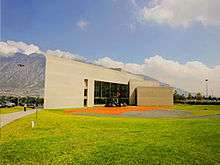Fernando González Gortázar


Fernando González Gortázar (born 19 October 1942, Mexico City) is a Mexican architect, sculptor and writer, considered to be one of the most influential Mexican architects of the 20th century.[1]
Biography
Fernando González Gortázar grew up and spent his youth in Guadalajara, Jalisco, and has lived in Mexico City, where he was born, since 1990. He studied architecture at the University of Guadalajara (Mexico) and received his BA in 1966, presenting as his thesis the project for a National Monument to Independence. As a student, he participated in several sculpture workshops with Professor Olivier Seguin at the School of Fine Arts of the same university.
He studied Esthetics with Pierre Francastel at the Superior School of Art and Archeology (now the Institute of Art and Archeology), and the Sociology of Art with Jean Cassou at the Collège de France, both in Paris (1967-1968). An architect, urbanist, landscape artist, scholar of Mexican folklore, he has fought for the preservation of the historical-cultural and ecological-natural heritage of Mexico.
Among his most important works, we find The Great Gate (1969), the Fountain of Sister Water (1970), the entrance to González Gallo Park and The Tower of Cubes (both from 1972), the Plaza-Fountain (1973), the González Silva House (1980), the Elf’s Walkway (1991), the Maya People’s Museum (1993), the Public Safety Center (1993), the Los Altos University Center of the University of Guadalajara (1993, still unfinished), the Chiapas Museum of Science and Technology (2005), and the Emblem of San Pedro (Fátima and the Flags Monument, 2011), and The Three Hairs of the Devil (2014), all in various cities in Mexico, as well as the Fountain of Stairs (Madrid, 1987) and The Escorial Tree (El Escorial, 1995) in Spain, and the Disjointed Column (1989) at the Hakone Open-Air Museum, in Japan.
In 2000, he held the Federico Mariscal Professorship of the Department of Architecture of the National Autonomous University of Mexico (UNAM). In 2009, he hosted Cancioncitas (Little Songs), 26 radio programs on Mexican popular music in the twentieth century, for Radio UNAM, which were later rebroadcast by several stations in Mexico and Colombia.
Prizes and distinctions
Fernando González Gortázar has an honorary doctorate from the University of Guadalajara.[1]
He was awarded the National Prize for Arts and Sciences in 2012.[1]
In 2014, a personal exhibition of González Gortázar was held at the Museo de Arte Moderno.[2]
Realized projects
- La Gran Puerta (1969), Guadalajara[3]
- La Columna Dislocada (1989) in the Hakone Open-Air Museum, Hakone, Japan
- Museo del Pueblo Maya (1993), Mérida[4]
- Museo Chiapas de Ciencia y Tecnología (2005), Tuxtla Gutiérrez
- Fuente de las Escaleras (1987), Madrid, Spain
Books
Books by Fernando González Gortázar
- Ignacio Díaz Morales habla de Luis Barragán (Ignacio Díaz Morales Speaks of Luis Barragán), 1990.
- Mathias Goeritz en Guadalajara (Mathias Goeritz in Guadalajara), 1991.
- La arquitectura mexicana del siglo XX (Mexican Architecture of the 20th Century), 1994, which he coordinated, and for which wrote the introduction and part of the text; republished in 1996 and 2004.
- La fundación de un sueño: la Escuela de Arquitectura de Guadalajara (The Founding of a Dream: the Guadalajara School of Architecture), 1995.
- Escritos reunidos (Collected Writings), 2004.
- Konstrukciók Struktúrak: a Magyar Épiszetben és Képzomuvészetben (Constructions and Structures: Architecture and Plastic Arts in Hungary), coauthored with Fábián László, 2006.
- Arquitectura: pensamiento y creación (Architecture: Thought and Creation), 2014.
- Las Torres de Ciudad Satélite (The Towers of Ciudad Satélite), 2014.
Books about Fernando González Gortázar (monographs)
- Fernando González Gortázar by Raquel Tibol, 1977. [5]
- Fernando González Gortázar by Manuel Larrosa, 1998.
- Fernando González Gortázar: Años de Sueños (Fernando González Gortázar, Years of Dreams), texts by Fernando Huici and Teresa del Conde, among others.
- Fernando González Gortázar: sí, aún (Fernando González Gortázar: yes, still) by Carlos Ashida, 2000.
- Fernando González Gortázar: Arquitectura y Escultura 1965-2001(Fernando González Gortázar: Architecture and Sculpture 1965-2001), texts by Fernando Huici and György Kévés, among others, 2001.
- Fernando González Gortázar by Antonio Riggen Martínez, 2005.
- Fernando González Gortázar: Centro Universitario de Los Altos (Fernando González de Gortázar: Los Altos University Center, Jalisco), by Miquel Adriá and Jaime Moreno Villareal, 2006.
- Fernando González Gortázar by Jaime Moreno Villarreal, 2008.
- Fernando González Gortázar: Series Dispersas (Fernando González Gortázar: Scattered Series) by Lelia Driben, 2009.
- Fernando González Gortázar: Resumen del Fuego (Fernando González Gortázar: Summary of Fire), texts by Carlos Mijares Bracho, José Luis Merino and Daniel Garza Usabiaga, among others, 2013.
References
- 1 2 3 Ávila, Sonia (21 December 2013). "Fernando González Gortázar: "No alcanza una vida"" (in Spanish). Excélsior. Retrieved 8 June 2014.
- ↑ "Fernando González Gortázar: Resumen del Fuego" (in Spanish). Mexico City: Museo de Arte Moderno. Retrieved 8 June 2014.
- ↑ "La Gran Puerta de nuevo está abierta" (in Spanish). Guadalajara: El Informador. Retrieved 9 June 2014.
- ↑ "Museo del Pueblo Maya de Dzibilchaltún" (in Spanish). Instituto Nacional de Antropología e Historia. Retrieved 9 June 2014.
- ↑ "El arte de González Cortázar, visto por Tibol" (in Spanish). Mexico City.